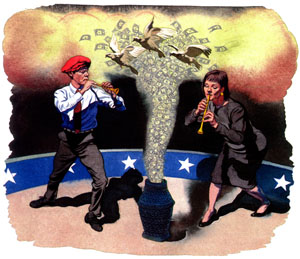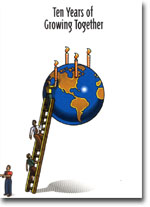
Funding Fever
Ten Years Of Growing Together - 1995 - AT&T Capital Corporation
By the fall of 1985, the business had begun to move ahead at what seemed to many people like a geometric progression gone mad. If the orders from the newly energized sales force didn't actually double every week, it certainly felt that way.
One BMD area manager received more than 100 voice-mail messages and made 12 personal visits to customers - every single day.
While the business boomed, the situation at GMD's outside processing center slid inexorably into chaos.
Workflow, wasteful to begin with, fractured beyond repair. Paper moved in endless circles, handed off from one person to another, and the n seemed to disappear in to thin air.
Area managers routinely sent in applications two or three times, only to be told that the forms were lost and the process would have to begin all over again. The faxes overflowed; a dozen machines spewed out an endless stream of applications 12 hours a day. When one locked cabinet was forced open, hundred of lost invoices came tumbling out.
Gerri Gold, now strategic business leader of AT&T Credit, recalls the phones: "The cubicles were high-walled, so you never knew exactly where the phone was ringing. When customers called, you had 30 people diving over their desks yelling, "Where's the phone? Where's the phone?"
The systems was on the verge of a complete breakdown and no one seemed to know except the customer - AT&T. And AT&T was getting worried.
Paul Gustavson, a California business consultant with AT&T's American Transtech unit, was called in to assess the GMD vendor system and offer suggestions.
"It wasn't a good situation," he says. "Very traditional, very hierarchical."
Paul's suggestions to redesign the operation along less conventional, more innovative lines went unheeded. Not surprisingly, the vendor system crashed. It was the precise opening they needed. AT&T Credit made the decision to take over the operation.
Jim Tenner was called in to lead the takeover. He'd had experience with American Transtech's unique organizational design approaches, and asked Paul to help work with the tam to develop the new organizational plan.
"I suggested a six-month program of change," Paul recalls, "and I considered that a real fast-track process."
Jim looked at him and said, "Paul, that's a great plan. The trouble is, we have to do all of it in two weeks."
They did it, formulating the new GMD organization around three basic principles. The new organization would be a wealth-creating one, and the wealth would be shared with those responsible for creating it through a series of percentage bonuses - an idea that went against the grain of AT&T policy at the time. The work would be customer-focused instead of task-focused - bottlenecks and extraneous operations would be identified ahead of time and eliminated. Finally, employees would be empowered to make decisions and trained to take end-to-end responsibility for each lese application, and idea that broke with the traditional structure of the leasing business.
The day of the takeover, Jim stood before the employees and told them the truth. "You've failed," he said. "Our customer is about to leave. But from this point on, we're not going to fail."
Most of them had no idea there was a problem, let alone that the business was in jeopardy. " We were in very serious danger of losing our customer," Jim remembers, "and that customer was the only reason we existed."
Creating the new process was easier than implementing it. "We had so much do to," Jim says. "First, we moved to a new location, and then we had to select the people we wanted to stay. We utilized competency evaluations for the first time, and tried role-playing to find the best people. We put our desks in the middle of the office because we wanted the employees to feel they could ask us questions at any time. And they did. We were inundated."
Very quickly, the enormity of the challenge they'd inherited became clearer. "It was worse than we had imagined," Jim says. "We started out working on triage theory, finding the invoices we thought we could save with quick action, and letting the others die."
A month and a half after the move, funding fever hit. According to one member, it started with a congratulatory call from AT&T General Business Systems (GBS). The message went roughly like this: "We're glad AT&T Credit is taking over. We love you. You owe us $13 million, and we want it in a month. Have a nice day."
Everyone wondered the same thing: How are we going to do it?
There were seven employees at the morning meeting, each selected as part of the team to handle the new crisis. It was early summer, most were casually dressed, drinking coffee and eating pastries that had been set out. The seven stopped eating when the leadership team explained what it wanted them to do - save the company.
"They told us how they wanted the company to work," Diane Gutschmidt remembers, "and how we were responsible for the way things got done. We were the ones in charge of coming up with a plan to fix the funding crisis, and they'd stand behind our decisions. We had a day to figure out what to do."
After the leaders left, one of the seven spoke up. "They've got to be kidding," he said. They weren't.
The seven spent the rest of the day devising a plan, and when they presented it to the leadership that afternoon, it was accepted.
"We knew what needed to be done," Diane says. "We had most of it in our heads. But funding a million dollars a day seemed impossible - we were used to something like $200,000. Figuring out how to fund that amount was crazy, like somebody telling you to drive to the moon and back and, by the ay pick up a pizza while you're at it."
Although Jim Tenner had told them how important the work was, he didn't tell them how difficult it was for him to hand over that kind of responsibility. "On an intellectual level, I wanted to be the one who grabbed the steering wheel whole the car was weaving side to side down the highway," Jim says.
Nor did he tell them that the car was doing more than weaving. It was headed straight for the trees. "I didn't know if they really understood what was at stake," Jim continues. "There was enormous concern at the highest levels in AT&T that if we couldn't get that money paid within a month, they were going to stop using GMD. In the face if that possibility, it took a lot of courage for Tom Wajnert and Irv Rothman to let us go down what was really an unknown path."
What Diane remembers is that her own personal fear meter was running high: "I'd say, nine or ten usually. I don't think it ever got lower than a five."
The seven worked on their own for a week and through the weekend, and then returned to the conference room for an update meeting with the leadership the following Monday.
Jim was as blunt as he'd been at the takeover meeting. The amounts weren't high enough, he said; they weren't closing the gap fast enough.
The seven listed in silent disbelief as Jim scrapped their plan, and with little discussion, abruptly replaced it with one devised by the leadership.
The shock of what seemed like a complete betrayal of everything they'd been told wore off once they were outside the conference room. "This isn't what they said it would be like," one said. "They told us to take responsibility, make the decisions, and now we're back to being the hired help."
No one remembers who made the first move, but somehow it was made: They were going back in the conference room to tell the leadership exactly what they thought.
"I guess we were pretty surprised when they came back," Jim remembers. No one knew how to deal with what amounted to open rebellion. So they listened.
This article was featured in Ten Years of Growing Together. "They challenged us to love up to our own rhetoric," Jim says. "They were right. We'd told them what we wanted the company to be, and we reneged. There was only one thing we could do. We let them go ahead with it."
From that point on, everyone worked on the funding. Extra people were hired to make the plan work. And in four weeks they managed to find and fund just under the $13 million demanded by GBS.
Jim remembers it was like a boxing match: "We'd get a little bloody, do come coaching and then head right back in for the next round."
It was a team effort. But more than that, it was the first successful transfer of project ownership from the leaders to the employees.
"They're the ones who really made it work," Jim says, "They set the standard. They had a sense that there was a better way of doing things and then showed us they could do it. Each time that happens, you become more comfortable with the process."
At the time, they didn't think of it that way. They were so focused on getting the work done that none of them ever considered the larger significance of what they'd accomplished until much later on.
Recalls Gerri Gold: "I don't think we focused on the big picture, it was more like getting in gear and doing it. So, at five o'clock, people would turn the radio on, change clothes, and keep right on working. Of course, the other thing I remember is never sleeping."
"It built up trust that wasn't there before," Diane says, "and made the next few months go a lot smoother because we finally realized we were all in it together. Before funding fever, we were just the hired help. But not afterward."
In a single six-week period, they'd not only saved the company, but had succeeded in creating an entirely new kind of company, something that in time would become the prototype for the future of the whole organization.


